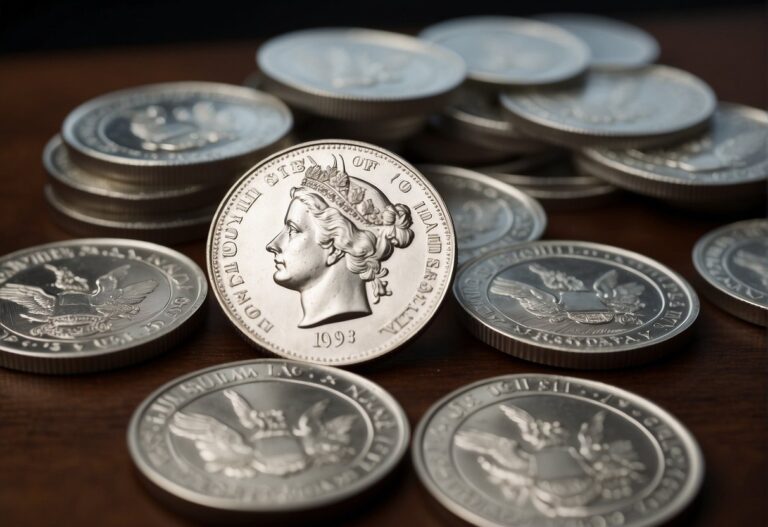A Gold IRA, or Individual Retirement Account holding physical gold, presents an alternative asset option for retirement saving that diverges from traditional stock or bond investments. By enabling investors to include gold in their retirement portfolios, these accounts offer a distinctive strategy for hedging against inflation and market volatility.
Click Here to Be Matched With a Top Gold Advisor For Free
With potential tax benefits similar to other IRAs, gold IRAs attract those seeking a tangible asset that has historically maintained its value.

However, as with any investment, there are considerations to consider. The costs and fees associated with a gold IRA tend to be higher than those for a traditional or Roth IRA, owing primarily to storage and insurance requirements for the physical gold.
Investors must also navigate a complex set of regulations and need to work with specialized custodians to set up and manage these self-directed IRAs. Therefore, it’s essential to understand the advantages and limitations before committing to this investment.
Key Takeaways of Gold IRA Pros and Cons
- Gold IRAs offer a hedge against inflation and portfolio diversification.
- They come with higher fees than traditional IRAs and require a specialized custodian.
- Consider regulatory complexities and potential liquidity constraints.
Understanding Gold IRA Pros vs Cons

Investing in a Gold IRA offers a way to diversify retirement portfolios with physical gold while providing potential tax advantages. This section will explore the foundation, variety, and operational aspects of a Gold IRA.
What is a Gold IRA?
A Gold IRA is a type of Self-Directed IRA (SDIRA) that allows investors to include physical gold or other approved precious metals as part of their retirement portfolio. Unlike a Traditional IRA or Roth IRA, which typically holds stocks, bonds, and mutual funds, a Gold IRA can include bullion coins, bars, and other IRS-approved forms of precious metal.
What Are the Types of Gold IRAs?
There are primarily two types of Gold IRAs, which correspond to the conventional IRAs:
- Traditional Gold IRA: Contributions are typically made pre-tax, and taxes are paid upon withdrawal during retirement.
- Roth Gold IRA: Contributions are made with after-tax dollars, and qualified distributions during retirement are tax-free.
In both cases, the accounts are self-directed, giving investors control over their precious metals investments.
How Do Gold IRAs Work?
To begin investing in a Gold IRA, one must take the following steps:
- Choose an IRA Custodian: Select a custodian that specializes in SDIRAs and is equipped to handle investments in physical gold.
- Fund the IRA: Contributions can be made up to the annual limit of $6,500 for individuals under 50 and $7,500 for those 50 or older in 2023.
- Select Precious Metals: Purchase IRS-approved gold or precious metals from a dealer.
- Store the Metals: By law, the physical gold must be stored in a secure, IRS-approved depository.
Investors may fund their Gold IRA through annual contributions or by transferring or rolling over assets from an existing retirement account.
What Are The Advantages of Gold IRAs?
Investing in a Gold IRA can offer unique benefits to an individual’s retirement strategy, such as safeguarding purchasing power and enhancing investment variety. These accounts are specifically tailored to incorporate precious metals, providing particular advantages that standard IRAs may not.

Hedge Against Inflation
Gold has historically maintained its value over long periods, making it a reliable hedge against inflation. In a Gold IRA, gold acts as a safeguard against the eroding effects of inflation on the purchasing power of the assets held within the retirement account.
Gold IRA Portfolio Diversification
Diversification is pivotal in minimizing risk, and Gold IRAs contribute to a balanced investment portfolio. By adding gold—a commodity that often moves inversely to stocks and bonds—investors can reduce the risk of overexposure to a single asset class, thereby protecting their portfolio.
Gold IRA Tax Benefits
Gold IRAs offer tax advantages, which can be significant. Contributions to traditional Gold IRAs may be tax-deductible, and the capital gains on the gold investment grow tax-deferred, providing tax benefits similar to those associated with traditional IRAs.
Although contributions are not deductible for Roth Gold IRAs, qualifying withdrawals are tax-free, offering a tax-efficient way to gain from gold’s potential growth.
Gold IRA Cons: Risks and Considerations

When considering a Gold IRA, investors must be aware of factors such as market volatility, associated fees and costs, and liquidity concerns, which can dramatically affect the value and accessibility of their investment.
Precious Metals Market Volatility
The value of gold can be highly volatile and fluctuates due to numerous factors, including economic conditions, monetary policy, and global events. While it can be a hedge against inflation, gold prices can still experience significant short-term swings, potentially impacting Gold IRA values.
- Historical Volatility: Gold has seen periods of rapid price changes.
- Economic Indicators: These often influence the price of gold’s market price.
Gold IRA Fees and Costs
Investing in a Gold IRA has various fees that can affect overall returns. Maintenance and storage fees are recurrent and can vary widely among providers.
- Maintenance Fees include setup, administrative, and yearly fees.
- Storage Fees: Custodians often charge for insuring and storing physical gold.
Comparison of Typical Fees:
| Fee Type | Range |
|---|---|
| Setup Fee | $50 – $150 |
| Annual Admin Fee | $75 – $300 |
| Storage Fee | 0.5% – 1% of assets |
Gold IRA Liquidity Concerns
Gold IRAs are less liquid than traditional IRAs holding stocks or bonds. Selling physical gold typically requires more time and can involve additional steps, which might be better for investors who value quick and easy access to their funds.
- Selling Process: It can be longer due to the need for physical asset verification.
- Market Dependency: Liquidity may depend on current gold market demand.
Gold IRA Investment Options

Investing in a Gold IRA allows individuals to diversify their retirement portfolio with precious metals. This section explores the different assets one can hold in a Gold IRA.
Types of Gold IRA Coins Bars and Bullion
Gold Bullion: Gold bullion is the most common form of investment in a Gold IRA, typically in bars or coins. The IRS has specific purity standards, requiring gold to be 99.5% pure.
Examples of IRS-approved gold investments include:
- American Eagle coins
- Canadian Maple Leaf coins
- Austrian Philharmonic coins
- Bars and rounds produced by an NYMEX or COMEX-approved refiner/assayer
Investors should note that collectible coins and those not meeting IRS purity requirements are not permissible.
Gold Stocks and Mutual Funds: While not a direct investment in physical gold, investors can also hold stocks of gold mining companies or mutual funds that include gold stocks. These options offer exposure to gold performance but can be more volatile due to being linked to stock market performance.
Other Precious Metals IRAs
In addition to gold, a Gold IRA can include other precious metals, which must also meet IRS purity standards.
Allowable Precious Metals:
- Silver: Must be 99.9% pure. Standard investment options include American Eagle silver coins and silver bullion bars.
- Platinum: Must be 99.95% pure. Investors can choose from Platinum American Eagle coins and platinum bars accredited by reputable sources.
- Palladium: Must be 99.95% pure. Palladium investments include bars and coins like the Canadian Maple Leaf palladium coins.
Investing in these metals can further diversify a retirement portfolio; however, their markets can fluctuate like gold, impacting the overall investment value.
Setting up a Gold IRA

A Gold Individual Retirement Account (IRA) requires careful selection of a qualified custodian and an understanding of the account setup process. These initial steps are crucial in integrating precious metals into one’s retirement portfolio.
Choosing a Gold IRA Custodian
When setting up a Gold IRA, individuals must select a custodian—a financial institution that the IRS approves to hold IRA assets on behalf of the account holder. The custodian is responsible for the security and compliance of the precious metals in the IRA. While evaluating potential custodians, investors should compare:
- Custodian fees: These may include setup, annual storage, and transaction fees.
- Services provided: Some custodians offer additional services such as investment advice or help buying and selling gold.
- Reputation and reliability: It is advisable to research the custodian’s track record and customer reviews.
Choosing the proper custodian is essential for ensuring the gold’s security and the Gold IRA’s compliance with IRS regulations.
The Gold IRA Account Setup Process
After selecting a custodian, setting up the Gold IRA involves several specific steps:
- Application: Fill out the custodian’s application form to open a new IRA account.
- Funding the account, which can be done through:
- Transfers from other IRAs
- Rollovers from qualified retirement plans
- Cash contributions
- Purchasing gold: Investors must select the gold products to include in their portfolio once the account is funded. Only certain types of gold (specified by the IRS) can be held in an IRA.
- Storing the gold: The precious metals must be stored by IRS regulations, generally in an approved depository.
Investors should be attentive to account setup and custodian fees associated with the Gold IRA, as these can vary. They may affect the overall cost-effectiveness of the investment strategy.
Financial Planning with Gold IRAs

When considering Gold IRAs for retirement planning, investors should weigh the compatibility with their long-term financial goals and match their risk tolerance with the asset’s characteristics. A financial advisor can provide guidance tailored to individual circumstances.
Investing for Retirement
In retirement accounts, a Gold IRA is an option for investors seeking diversification beyond traditional stocks and bonds. Diversification is crucial in mitigating risk, and gold often moves independently of the stock market.
This can be particularly advantageous during economic downturns or periods of high inflation when gold prices often increase.
However, individuals must consider the costs associated with a Gold IRA, including setup fees, storage fees, and potential selling commissions, which can impact overall returns.
Tax Considerations: As with any IRA, the tax advantages of a Gold IRA include potential tax-deferred growth, with taxes being paid only upon distribution. Just so you know, specific rules apply to the physical gold in the account, as it must be stored in a depository approved by the IRS.
Aligning a Gold IRA with Long-Term Financial Goals
A Gold IRA may align with an investor’s financial goals if it fits within their risk tolerance and investment horizon. It’s paramount that the investment decision to allocate a portion of retirement savings into gold reflects a well-considered strategy. They should review whether this inclusion enhances their portfolio’s resilience against market volatility.
Risk Analysis: An individual’s risk tolerance should inform their allocation in gold. Investors nearer to retirement age may be more risk-averse and find the stability of gold appealing, while younger investors might prioritize assets with higher growth potential. In either case, a thoughtfully allocated Gold IRA can be a strategic component of a broader, balanced portfolio.
I’d recommend you consult with a financial advisor to navigate these considerations effectively, as they can help tailor a strategy that best suits one’s financial plan and retirement objectives.
Gold IRA Regulations

Gold Individual Retirement Accounts (IRAs) are subject to specific regulations set by the IRS, which affect contributions, distributions, and the types of gold investments allowed. Adherence to these rules is crucial for the tax-advantaged status of the IRA.
IRS Rules & Guidelines
The Internal Revenue Service (IRS) mandates that the gold in a Gold IRA meet specific fineness standards. Specifically, the gold must be 99.5% pure. Only certain coins and bars are eligible; an IRS-approved custodian must hold these. The custodian is critical in managing the IRA and ensuring compliance with IRS regulations.
Eligible Gold Products:
- American Eagle coins
- Canadian Maple Leaf coins
- Austrian Philharmonic coins
- Certain bars and rounds produced by accredited manufacturers
The IRS does not allow investors to store their IRA gold at home; it must be kept in a secure depository that meets their standards.
Contribution and Distribution Limits Of Gold IRAs
For the tax year 2023, the contribution limit to a Gold IRA is $6,500 for individuals under 50. For those aged 50 and above, a catch-up contribution of $1,000 is permitted, increasing the limit to $7,500. These contributions are typically made with after-tax dollars, especially in the case of a Roth Gold IRA.
Contribution Limits:
| Age | Contribution Limit |
|---|---|
| Under 50 | $6,500 |
| 50 and Above | $7,500 |
Distributions from a Gold IRA follow the same rules as other IRAs. Depending on whether it is a Roth or Traditional IRA, they may be tax-free or tax-deferred. A Traditional Gold IRA taxes distributions as ordinary income at withdrawal.
Individuals must also start taking Required Minimum Distributions (RMDs) from their account at age 72. Failure to comply with these distribution rules can result in significant tax penalties.
Gold IRA Transfers and Rollovers

When considering funding options for a Gold IRA, individuals typically have two methods: a transfer or a rollover. These processes facilitate the movement of funds from traditional retirement accounts into a gold-backed IRA, each with specific procedures and tax implications.
How to Rollover Existing Retirement Funds To Gold
To initiate a Gold IRA rollover, one must first decide on the rollover type: direct or indirect. A direct rollover involves the transfer of funds from a traditional IRA or 401(k) directly to a Gold IRA, with the financial institution managing the transaction. This process is typically favored for its simplicity and because it avoids any tax withholding.
In contrast, an indirect rollover allows the account holder to take possession of the retirement funds, which they then have 60 days to redeposit into a Gold IRA to avoid taxation.
Just to let you know, only one indirect rollover is permitted in 12 months, and failure to redeposit the funds within 60 days can lead to significant taxes and penalties.
- Choose Rollover Type:
- Direct Rollover: Institution-to-institution transfer.
- Indirect Rollover: The 60-day window for re-depositing funds.
- Contact your current IRA custodian to initiate the rollover process.
- Select a Gold IRA custodian and open a new IRA account if necessary.
- Complete the required paperwork to ensure a smooth transaction.
Gold IRA Transfer Procedures
A Gold IRA transfer is another funding option, generally more straightforward than a rollover. Transfers are nearly always accomplished as a direct trustee-to-trustee transfer, meaning the money moves directly from one IRA custodian to another without the account holder ever taking control of the funds.
This simplicity makes the risk of missing deadlines or incurring taxes and penalties virtually nonexistent.
Transfers can also be done multiple times per year, as opposed to the once-per-year limit of an indirect rollover. Roth Gold IRAs are also eligible for transfers, maintaining the Roth IRA’s tax-free status for qualifying distributions.
To execute a transfer, the investor needs to:
- Ensure the current IRA supports gold investment if transferring within existing accounts.
- Select a Gold IRA custodian experienced in physical precious metals.
- Complete a Transfer Request form, often provided by the new custodian.
- The new custodian will coordinate with the existing custodian to transfer the funds.
Both rollover and transfer methods are integral parts of an investment strategy, offering a means to diversify one’s retirement portfolio. Deciding between them depends on an individual’s financial circumstances and investment goals.
Costs and Fees Associated with Gold IRAs

Investors should know that Gold IRAs incur several fees that can impact the overall investment cost. These fees can vary widely among providers, so understanding and comparing them is crucial for making informed decisions.
Understanding Gold IRA Rollover Fees
Custodian Fees: Custodians safeguard the physical precious metals in a Gold IRA. They typically charge an annual fee ranging from $50 to $300, which may be higher depending on the account balance.
Storage Fees: Keeping gold and other precious metals safe and secure involves storage fees. Investors must pay to store their precious metals, often conducted by the custodian or a third-party depository. These charges can be a flat fee or a percentage of the account value, usually from $100 to $300 per year.
Insurance Costs: Insurance is critical in protecting an investor’s assets against theft or damage. Insurance costs are often included with the storage fee, but sometimes, they are listed separately and can vary depending on the value of the gold in the IRA.
Management Charges: Some Gold IRA providers may also charge management fees for the ongoing administration of the IRA. This could be a flat fee or a percentage of the IRA value.
Fee Structure: It’s important to note that the fee structure for Gold IRAs may include one-time setup fees, scaling fees based on account size, transaction fees for buying or selling metals, or may be scaled with account size. Some providers may also charge a buy-sell spread.
Comparing Costs Among Gold IRA Providers
Comparing the fee structures between different providers is essential when evaluating Gold IRA options. Investors should carefully examine:
- Annual custodian fees
- Storage and insurance fees
- Any additional management or administrative fees
Investors can often find this information in the provider’s fee schedule. I think it’s best to ask for a full disclosure of all fees to avoid surprises and make comparing different investment options easier.
Exit Strategies and Liquidation Of Gold IRAs

When planning an exit strategy for a Gold IRA, an investor must consider the liquidity of their precious metals and the regulations regarding Required Minimum Distributions (RMDs). Critical factors include the ease of converting metals to cash and the implications on a retirement portfolio.
Selling Your Precious Metals
In a Gold IRA, liquidity refers to how quickly and easily one can sell the precious metals for cash. Timing is essential; deciding when to sell impacts the retirement portfolio’s value. Investors typically have two main options:
- Sell to a Dealer: This process is often faster but may result in lower returns.
- Sell to Another Investor: Potentially higher returns, but it could take longer to find a buyer.
Factors affecting liquidity include current market demand, the purity of the precious metals, and prevailing market prices. It’s recommended that investors keep these factors in mind to ensure a streamlined liquidation process, considering any fees or potential penalties for early withdrawal.
Handling Required Minimum Distributions
Upon reaching a certain age, the IRS mandates that investors must begin taking Required Minimum Distributions from their retirement accounts, including Gold IRAs:
- Age Requirement: Investors must start taking RMDs at age 72.
- Distribution Amounts:
- Determined by the IRS Uniform Lifetime Table.
- Calculated based on the account balance and the account holder’s age.
Failing to comply with RMD rules can result in substantial penalties, which include a 50% excise tax on the amounts not distributed as required. Careful planning is necessary to meet these requirements while avoiding early withdrawal penalties and ensuring the investor doesn’t undermine the financial integrity of their retirement portfolio.
Gold IRA Frequently Asked Questions

Investing in a gold Individual Retirement Account (IRA) involves unique considerations regarding tax implications, investment strategies, and adherence to regulations.
What are the benefits and drawbacks of investing in a Gold IRA?
Gold IRAs offer diversification of retirement assets and a hedge against inflation. However, they come with storage costs and lack equity dividends.
How does investing in a Gold IRA compare to owning physical Gold directly?
Owning gold through a gold IRA includes tax advantages, secure storage, and convenience, while direct ownership provides personal control and quick access to the metal with no custodian fees.
What are the potential tax implications of a gold IRA?
A gold IRA offers tax-deferred growth or tax-free withdrawals for Roth IRAs. Tax implications vary by account type and must align with IRS regulations for collectibles within IRAs.
What are the annual contribution limits for a Gold IRA?
The annual contribution limits for gold IRAs match those of traditional and Roth IRAs; in 2023, the limit is $6,500, or $7,500 for individuals aged 50 and above.
What should one consider when choosing a gold IRA company?
One should assess a gold IRA company’s fees, storage options, and reputation, including their experience and customer service track record.
How might the performance of a gold IRA align with an individual’s retirement strategy?
A gold IRA may provide balance in a retirement portfolio, operating as a counterweight to more volatile assets, thus offering stability as one nears retirement.



